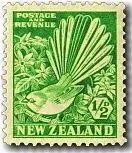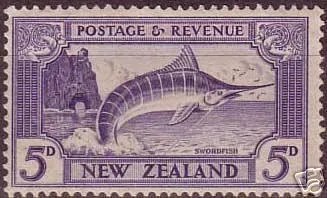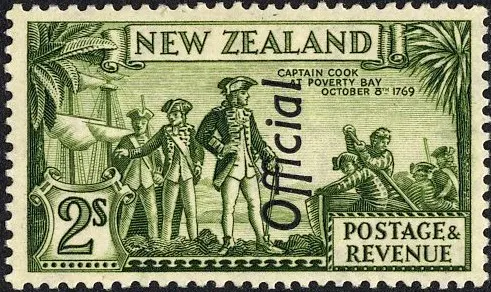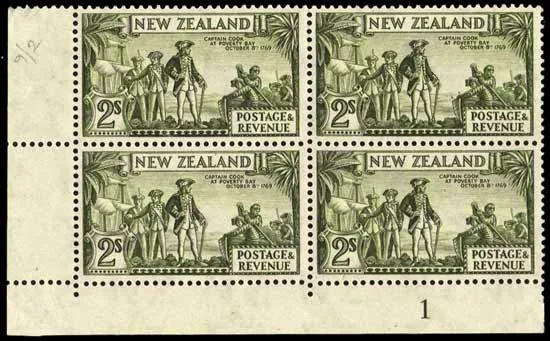Definitive Tour.
The 1935 Pictorial Issue.
By 1931 several of the plates for the King George V definitive stamps were noticeably worn. Given that the design of the 1926 Admirals issue had been severely criticised, the authorities decided to try the same approach which had worked so well in 1898 - a design competition for a new set of pictorial stamps.
Entries were divided into New Zealand subject groups: fauna, scenery, Maori art, agricultural, history and sport, then examples were chosen for the stamps being issued. Over 1,500 entries were received and designs from eleven contributors were included in the final set. Some unsuccessful entries can be seen at the bottom of this post.
The stamps suffered a series of delays though - printing by photogravure was abandoned in favour of line etching with the exception of the ninepenny stamp which was the first New Zealand stamp printed by offset lithography. There were also issues with paper quality and the shilling stamp design was changed again just before issue. Finally, in 1935 the set was ready to be issued.
½d - Fantail. 1d - Kiwi. 1½d - Cooking.
½d - Fantail.
The (Collared Grey Fantail) or 'piwakawaka' in Maori. This pleasant and friendly little native bird is frequently seen in the bush, even in areas close to towns and cities. The bird's name derives from its beautiful tail of twelve feathers, which broadly expands as the bird flits about. In the background of the design is one of the best-known flowers of the New Zealand bush, the beautiful clematis.
1d - Kiwi.
New Zealand has more varieties of flightless birds than any other country, and the kiwi is one. The bird is unique in that its nostrils are placed at the extreme end of its beak and its nasal passage is more complicated than that of any other bird. Although most bird's sense of smell is usually small, that of the kiwi's is high. It is nocturnal with its habits, issues a loud whistling cry, and sniffs audibly when hunting food.
1½d - Cooking.
This stamp depicts a young Maori woman in traditional dress lowering a 'kete' of food into a boiling spring for cooking. A 'kete' is a basket plaited from flax. Although this is presented as being common around the thermal areas of the North Island, the chemical content in the water of many hot springs would make them unsuitable for cooking, if not poisonous.
New Zealand Maori Index. Definitive Stamps with Maori Themes.
The (Collared Grey Fantail) or 'piwakawaka' in Maori. This pleasant and friendly little native bird is frequently seen in the bush, even in areas close to towns and cities. The bird's name derives from its beautiful tail of twelve feathers, which broadly expands as the bird flits about. In the background of the design is one of the best-known flowers of the New Zealand bush, the beautiful clematis.
1d - Kiwi.
New Zealand has more varieties of flightless birds than any other country, and the kiwi is one. The bird is unique in that its nostrils are placed at the extreme end of its beak and its nasal passage is more complicated than that of any other bird. Although most bird's sense of smell is usually small, that of the kiwi's is high. It is nocturnal with its habits, issues a loud whistling cry, and sniffs audibly when hunting food.
1½d - Cooking.
This stamp depicts a young Maori woman in traditional dress lowering a 'kete' of food into a boiling spring for cooking. A 'kete' is a basket plaited from flax. Although this is presented as being common around the thermal areas of the North Island, the chemical content in the water of many hot springs would make them unsuitable for cooking, if not poisonous.
New Zealand Maori Index. Definitive Stamps with Maori Themes.
2d - Whare. 2½d - Mount Cook.
2d - Whare.
Upon arrival in New Zealand, the Maori found they needed warmth and protection from the wind and rain, unlike the tropical islands from which they had come. They developed the style of large, rectangular community or meeting houses made from wooden planks with thatched, gabled roofs and doors recessed behind deep verandas. Their living quarters or 'whare' were built in a similar but smaller and simpler style with little or no carvings. In the background are two native trees, one of the tree ferns on the left and a cabbage palm on the right.
2½d - Mount Cook.
This is one of three two-toned stamps found in this set. Mount Cook, the highest mountain in New Zealand, is named after Captain James Cook, the explorer who discovered much of New Zealand. (See the 2/- stamp below.) The early Maori immigrants in the Arai-te-uru canoe named the mountain 'Aorangi' after their Chief's grandson. The lily (Ranunculus lyallii) depicted on the border of the stamp is one of the most distinctive of New Zealand 's alpine flora. It grows only on the high mountains of the South Island.
3d - Wahine. 4d - Mitre Peak. 5d - Swordfish.
3d - Wahine (young Maori girl).
The young Maori girl is illustrated wearing a 'pare', or headband of plaited flax, dyed red and black, or left the natural colour of the dried silky fibre. In her hair is a feather of a huia, a native bird now extinct. Suspended by a flax cord fastened around her neck is the characteristic Maori amulet - 'tiki".
The young Maori girl is illustrated wearing a 'pare', or headband of plaited flax, dyed red and black, or left the natural colour of the dried silky fibre. In her hair is a feather of a huia, a native bird now extinct. Suspended by a flax cord fastened around her neck is the characteristic Maori amulet - 'tiki".
4d - Mitre Peak.
This is one of the most famous of the many wonderful scenes to be found in the picturesque Fiordland of the South Island. Mitre Peak (1695 metres) stands at the head of Milford Sound and its the first sight seen by visitors. The ti-tree (manuka) fills the borders of the stamp, and the four stars in each of the lower corners suggest the Southern Cross.
This is one of the most famous of the many wonderful scenes to be found in the picturesque Fiordland of the South Island. Mitre Peak (1695 metres) stands at the head of Milford Sound and its the first sight seen by visitors. The ti-tree (manuka) fills the borders of the stamp, and the four stars in each of the lower corners suggest the Southern Cross.
See our post - Mitre Peak/Milford Sound.
5d - Swordfish.
This stamp depicts a striped marlin sword-fish, one of several species of big-game fish to be found in New Zealand waters, leaping from the water after being hooked. The rock on the left is Piercy Island, near Cape Brett, you can see the famous cave, 'The Hole In The Rock', that the tour boats go through. This is a popular fishing-ground for sword-fish and the fierce mako shark. In the top corners of the stamp can be seen bow carvings from Maori canoes.
Two colour varieties of the 5d - Swordfish.
On the left is a purple/blue and on the right is the rare cobalt blue.
6d - Harvest. 8d - Tuatara.
6d - Harvest - the Reaper.
This design features a horse-drawn harvester or reaper, working through a crop of wheat. This is hardly a typical design of New Zealand farming because even back in 1935 mechanical harvesting was much more common.
8d - Tuatara.
The tuatara is a link between the lizard and the crocodile and is the sole living representative of some of the oldest creatures that ever inhabited the earth - the only surviving member of the Sphenodontians which flourished around 200 million years ago. The name "tuatara" derives from the Māori language meaning "peaks on the back". The tuatara is peculiar in having the relic of a third eye. It is 30 - 45 centimetres in length, covered with a grey, leathery, wrinkled skin. The average lifespan of a Tuatara is about 60 years, but they can live to be well over 100 years old. Some experts believe that captive tuatara could live as long as 200 years.
9d - Waterlow and Sons. 9d - Coulls Somerville Wilkie.
9d - Maori decoration.
The 9d stamp features the ornamentation from a Maori sliding door panel. This stamp was printed using offset lithography rather than recess printed like the rest of the stamps in the issue. The stamp was issued in two main forms. The initial prints from plates first prepared by Waterlow and Sons and subsequently by Coulls Somerville Wilkie with the stamp design measuring 18 by 21½ mm are quite variable in colour from dull red, bright red and brick red with the frame in dull grey, slate grey or black. Later printings from new plates from Coulls Somerville Wilkie have a smaller design measuring 17½ by 20½ mm (with a subsequently larger white border) and are consistently scarlet against a shiny black frame. The stamps are best distinguished by the size of the design and width of the border, as not all of the initial larger design printings have a grey border.
1/- Tui. 2/- Landing of Captain Cook.
1/- Tui.
A number of New Zealand birds are songless, but the beautiful tui is a notable exception. It is an inimitable songster, a remarkable mimic, and it can be taught to talk. Between 30 and 38 centimetres in length, the tui has two tufts of white feathers at its throat, a collar of long white curved feathers on the back of its neck, and a touch of white on the angle of its wings. Its body is in two shades of brown, and its wings and neck feathers are iridescent, gleaming green or blue according to the play of light on the feathers.
2/- Landing of Captain Cook.
Captain James Cook landed at Poverty Bay on 8 October 1769, during his first voyage in the Pacific. The first encounter with local Maori led to the deaths of six Maori during skirmishes with the crew due to a misinterpretation of the traditional Maori challenge. Poverty Bay was so named because of the unwelcome reception accorded to the explorers by the local natives and their resulting inability to obtain provisions. The stamp shows a fern-tree on the left, a cabbage tree on the right, with Cook's ship the Endeavour in the background.
See our collection of Capt. Cook stamps - Captain Cook Stamps of New Zealand.
3/- Mount Egmont/Taranaki.
3/- Mount Egmont/Taranaki.
A pastoral view with Mount Egmont / Mount Taranaki in the background. Mount Taranaki is a dormant stratovolcano on the west coast of the North Island. Sometimes compared to Mt Fujiyama, the mountain sits by itself, rising from the Taranaki farmland far from the other volcanic mountains in the central North Island. It is geologically young - volcanic activity commenced around 135,000 years ago. Egmont was named in 1770 by explorer James Cook as he sailed past but the Maori name Taranaki (Barren Mountain) was given equal and official status in 1986.
1935 Pictorials Officials.
12 of these stamps were overprinted with the word 'Official' for use by Government Departments.
To view all the 'Official stamps produced by New Zealand visit An Official Post.
½d - Fantail. 1d - Kiwi. 1½d - Cooking.
2d - Whare. 2½d - Mount Cook.
3d - Wahine. 4d - Mitre Peak.
6d - Harvest. 8d - Tuatara. 9d - Maori decoration.
1/- Tui. 2/- Landing of Captain Cook.
Flaws and Errors.
Dots over the Bow.
In this block of four stamps, there are two dots that can be seen just above the bow of the dingy on the stamp to the top right-hand.
The 'Q' Flaw.
The famous 'Q' flaw. A small mark can be seen on the second 'O' in the word 'Cook' which turns this letter into a 'Q'. To the right is an enlargement of this area of the stamp.
Falling Coconuts.
If you look at the tree to the right, you can see two dots that some have suggested resemble falling coconuts.
Famous Tekoteko Flaw.
An orange mark can be seen in the sky above the roof of the meeting house.
Offset on the Back.
Brown from the mountains on the 2½d - Mount Cook can be seen offset onto the stamp above. This is caused by the ink not drying quickly on the stamp before the next sheet landed on top, either too much ink was applied or the ink not mixed properly. The mark top centre has been left by a stamp hinge.
9d - Maori Decoration - the overprint "Official" is offset on the back.
Notice the bottom tawn corner as proof this is the same stamp, front & back view.
Designs That Weren't Used.
I mentioned above that a design competition was held that attracted some 1,500 entries. Below are some designs that didn't make the final selection but were kept by the Post Office.
1935 Pictorial Photo Essay of 1/- value from the design competition submitted for 1935 issue. Although the design was not used it is virtually identical to 1960 Pictorial 5/- design.
1935 Pictorial, unadopted stamp design, 2d Maori design in blue.
1935 Pictorial unadopted stamp design, 3d Waitomo Caves.
1935 Pictorial unadopted stamp design, 4d Franz Josef Glacier.
1935 Pictorial unadopted stamp design, 8d Rotorua thermal area with Maori figure.
1935 Pictorial unadopted stamp design, 9d Bush Scene.
Technical information:
Date of Issue:
| 1 May 1935 |
|---|---|
Designers:
| J Fitzgerald, Christchurch; C H & R J G Collins, Christchurch; M Matthews, Wellington; H W Young, Auckland; LC Mitchell, Wellington; R E Tripe & W J Cooch, Wellington; T I Archer, Nasik, India; I F Calder, Wellington; M King, Wellington and T H Jenkins, Invercargill |
Printers:
| Thomas De La Rue, England; Government Printing Office, New Zealand and Waterlow and Sons, England |
Stamp Size:
| 1/2d, 1d, 1 1/2d, 2d, 3d, 9d (earlier printings) and 1s : 21mm x 24mm; 2 1/2d, 5d, 2s and 3s : 40.5mm x 24mm; 4d and 8d : 25mm x 29mm; 6d : 29mm x 25mm; 9d (later printings) : 17.5mm x 20.5mm |
Sheet Size:
| 1/2d, 1d, 1 1/2d, 2d, 3d, 9d and 1/-: 240 stamps per sheet (one print of 9d: 120 stamps per sheet); 2 1/2d and 3/-: 60 stamps per sheet; 4d: 80 stamps per sheet; 5d and 2/-: 120 stamps per sheet; 6d and 8d: 160 stamps per sheet; Booklets containing 1d stamps; Coils of 2d, 5d, 6d, 8d and 1s stamps |
Process:
| Recess printed - Intaglio; 9d : Surface printed - Typography |
Paper Type:
| Various, with single or multiple NZ and star watermark. |
Some of the images in this post were used with permission from the illustrated catalogue of StampsNZ
You can visit their website and On-line Catalogue at, http://stampsnz.com/











































Comments
Post a Comment
We appreciate your engagement with our content. To ensure a respectful and constructive community, please take note of the following:
- No Spam, Please: We do not tolerate spammy or promotional comments. Any such comments will be promptly removed.
- Moderation in Place: All comments are moderated to maintain a positive and inclusive environment. Please be patient, as it may take a little time for your comment to appear.
- Sign In with Google: To comment, please sign in using your Google account. This helps us maintain the integrity of our community and allows for better interaction.